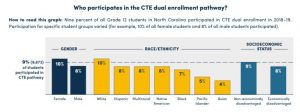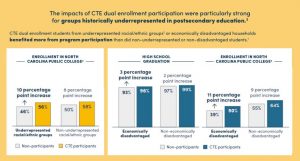![]() This series features interviews with three researchers— Julie Edmunds, Shaun Dougherty and Rachel Rosen — to highlight new and relevant Career Technical Education (CTE) research topics being pursued and discuss how state CTE leaders might leverage these to make evidence-based decisions. This series is conducted in partnership with the Career and Technical Education Research Network, which is providing new CTE impact studies and strengthening the capacity of the field to conduct and use rigorous CTE research.
This series features interviews with three researchers— Julie Edmunds, Shaun Dougherty and Rachel Rosen — to highlight new and relevant Career Technical Education (CTE) research topics being pursued and discuss how state CTE leaders might leverage these to make evidence-based decisions. This series is conducted in partnership with the Career and Technical Education Research Network, which is providing new CTE impact studies and strengthening the capacity of the field to conduct and use rigorous CTE research.
For the first post in this series, Advance CTE conversed with researcher Julie Edmunds to learn more about the outcomes of her study, The Evaluation of Career and College Promise, that evaluates North Carolina’s CTE dual enrollment pathway. The study is based on demographic and academic achievement data for 525,000 students in grades 11 and 12 who participated in North Carolina’s Career & College Promise CTE Pathway from 2012 to 2019, and a comparison group of similar students who did not participate in it.
As state CTE leaders seek replicable, high-impact strategies to implement dual enrollment and pathways programs, Edmund’s study presents a state-level glimpse into the impact and cost-effectiveness of these programs. This ongoing evaluation includes three sub-studies that build upon existing projects funded through grants from the Institute of Education Sciences (IES), two in New York City and one in North Carolina.
How do your research findings advance our understanding of how dual enrollment can enhance the learner experience?
We know many students are taking college-level CTE courses while they are still in high school, but we know very little about who takes these courses and whether they matter for students. Our findings suggest that these courses do have positive impacts; therefore, policymakers may want to look at ways of expanding access to CTE dual enrollment to more students.
One interesting finding is that the female students are just as likely (in some cases, more likely) to participate in CTE dual enrollment than male students, a trend that is different than most CTE programming. This does make us wonder if offering dual enrollment courses might be a way to make CTE courses more attractive to female students.

What findings would you highlight for state CTE leaders in particular?
Our findings show that CTE dual enrollment pathways led to positive outcomes for students in their transition from high school to college. Students participating in dual enrollment pathways graduated from high school at rates 2 percentage points higher than their peers, and they were also 9 percentage points more likely to enroll in postsecondary education, particularly in community colleges. The results were even higher among historically marginalized students (see graphic below). To help more students realize these benefits, state leaders will want to think about putting policies in place to support dual enrollment. For example, many states cover the tuition costs of these courses, which helps ensure that access to dual enrollment is more equitable.
What have you and your team learned about the availability and use of high-quality data on dual enrollment pathways and outcomes in North Carolina?
North Carolina has very rich student-level data (course-taking, behavior, completion, academic performance, etc.). Over the past 10 years or so, the state has been working on creating a longitudinal data system that links students from PreK to the workforce. These linkages have allowed us to look at the longer-term postsecondary impacts of participation in dual enrollment courses. In states where there is no link between education and workforce sectors, there would be no way to assess the high school and postsecondary programs. This poses particular challenges for CTE, where the outcomes are intended to make a difference in students’ experiences both during and after high school. A longitudinal identifier that follows students over time is the most crucial part of the data system.

What is the significance of developing a cross-sector research agenda? What commitments (e.g. staff-time, resources, etc.) are necessary for successful implementation?
Because CTE has long-term goals relative to post-high school preparedness (both career and college), a cross-sector research agenda is necessary to meaningfully answer impact questions. As I noted in the previous question, the key enabling factor is a data system that allows for the linking of students across sectors.
CTE dual enrollment is, by its very nature, a cross-sector program where high schools and colleges need to partner to ensure effective program implementation. Our past research suggests that effective dual enrollment partnerships benefit from several key factors:
1) a willingness for each side to understand where the other is coming from; 2) a focus on meeting the needs of students, even if it involves rethinking policies; and 3) staff who understand multiple perspectives, such as those who have worked in both K-12 and higher education, and who have a specific time allotted to dedicate to the partnership.
What new questions has this work raised for you that could be applied to future research?
I sometimes think that we end our research projects with more questions than we have answered. Here are a few that we are thinking about now:
- We want to understand more about how students are using their CTE dual enrollment courses. Are students applying these credits to workforce-focused majors? Are they using these credits and any credentials they have earned in their careers?
- We also have some evidence that CTE dual enrollment might be moving some students away from four-year colleges and into two-year institutions. We’d like to understand more about this. Is this because students recognize that what they want to do does not require a four-year degree? Are CTE dual enrollment students more likely to see community college as a valid, and much less expensive, way to get their first two years of college? Is it shifting their aspirations in some way; if so, how?
- Then, there are lots more questions about the implementation of CTE dual enrollment programs and how that implementation might differ from dual enrollment programming focused on college transfer.
Overall, there is so little research on CTE dual enrollment that there are so many topics to consider.
Visit Advance CTE’s Learning that Works Research Center for additional resources regarding dual enrollment, including a recent State of CTE report on Early Postsecondary Opportunities (EPSOs).
The work of the CTE Research Network Lead is supported by the Institute of Education Sciences at the U.S. Department of Education with funds provided under the Carl D. Perkins Career and Technical Education Act through Grant R305N180005 to the American Institutes for Research (AIR). The work of the Network member projects is supported by the Institute. The opinions expressed are those of the authors and do not represent the views of the Institute or the U.S. Department of Education.
Amy Hodge, Policy Associate
